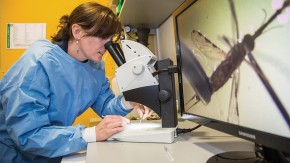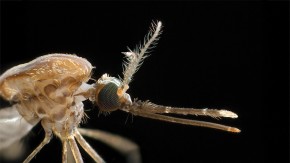Stefan Kappe holds a bottle of mosquitoes in the mosquito room, which also houses larvae in trays. Photo courtesy of Center for Infectious Diseases Research
A PROTECTIVE GENETICALLY ATTENUATED P. FALCIPARUM SPOROZOITE VACCINE
- Jan 1, 2016
- Download Retrospective

Stefan Kappe shows Bill Gates and colleagues how to get bitten by a mosquito. Photo courtesy of Center for Infectious Disease Research.
Stefan Kappe, Seattle Biomedical Research Institute, United States
In 2010, six healthy adults voluntarily placed their naked arms onto a net-covered container infested with mosquitoes for about 10 minutes, enough time to accumulate about 200 noxious bites. With each bite, swarms of weakened forms of the parasite that causes malaria surged from the mosquitoes' saliva into the volunteers' bloodstream. The study was not designed to give the test subjects malaria. Instead, it was to show that the parasites, which were weakened, or attenuated, through genetic engineering, could spur an immune defense against malaria without making people sick.
The experiment was testing whether the parasite - alive but genetically disabled - could serve as the basis for a vaccine. Fortunately for malaria vaccine research, human challenge studies like this one with malaria parasites can be safely conducted because the strains of parasites used are easily killed by antimalarial drugs should any of the volunteers actually get ill.
While unconventional, the approach at the time was considered promising by international public health organizations that have tried for decades to produce a fully protective malaria vaccine. "There was a good deal of biological evidence supporting it," says Ashley Birkett, director of the PATH Malaria Vaccine Initiative, a global research development organization. "The study received a lot of attention."
Absent a proven vaccine, malaria kills about 600,000 children a year, mostly living in sub-Saharan Africa. The clinical trial was a critical step in an ambitious undertaking by Stefan Kappe, a professor at the Center for Infectious Disease (CID) Research (formerly Seattle BioMed) and the University of Washington. It was the culmination of five years of team research funded by an initial US$13.9 million grant awarded by the Bill & Melinda Gates Foundation's Grand Challenges in Global Health (GCGH) program. The team consisted of the Kappe lab and research colleagues at the Walter Reed Army Institute of Research (WRAIR) in the U.S., the University of Heidelberg in Germany and the Walter and Eliza Hall Institute (WEHI) in Australia. Although the grant was among the largest of the 44 grants worth a total $450 million that GCGH handed out in 2005, it was viewed as a high-risk investment. But given the great need for a malaria vaccine, the gamble seemed worth it, if only to show whether it was even possible to create a laboratory engineered, weakened version of the parasite that could serve as the foundation for a vaccine.
The test results turned out to be the cause for cautious optimism for Kappe. But others in the field saw the study as a potentially fatal setback to the genetic approach for using a live but disabled parasite as a vaccine. Kappe had weakened the human malaria-causing pathogen by removing, or knocking out, two of the parasite's more than 5000 genes.[1] In animal studies with malaria parasites that infect rodents, the missing genes prevented the parasites from multiplying in the liver - its initial site of infection - and spilling into the bloodstream where they cause disease.[2] The human study was designed to replicate that finding. In five of the six test subjects, the absent genes disabled the parasite just as they had in the animal experiments. But in one of the volunteers exposed to a high dose, the parasite was robust enough to reproduce and enter the blood stage in its lifecycle.[3] For Kappe the partial success was enough evidence that attenuated parasites could be created by gene knockout technology. But Kappe and his colleagues also realized they needed to make the living parasites even weaker before they could be used safely as a vaccine.
After the study, Kappe didn't receive additional support from the Gates Foundation to continue the research when his grant ran out. Birkett says that creating a vaccine using a genetically attenuated parasite is still worth exploring. But, he says, the 2010 experiment did put a "black mark" on Kappe’s effort.
Birkett says by then funding organizations began looking at other concerns that cast doubt on whether a vaccine based on an attenuated parasite could ever be practical. For one, scientists have yet to develop a way to administer harmless parasites to people in one or two shots that make immunization campaigns in poor regions feasible. In addition, scientists can only breed the parasites inside mosquitoes, which would make scaling up the manufacture of a vaccine expensive and difficult. "It was one of those ideas that, at the time of the initial grant, people thought had a great deal of potential," says Stephanie James, director of the GCGH initiative for the Foundation for the National Institutes of Health, which oversaw the Kappe grant. "We now have a better appreciation of how difficult it will be."
In a conversation at his office in Seattle, Kappe bristles at that notion that his approach has hit a dead end. He acknowledges that the results were "disappointing." But condemning the trial as a failure, he says, is unfair and shortsighted. "Yes, we were surprised but not terribly shocked" by the results, Kappe says. "The anticipation that this would be a slam dunk was wishful thinking. It's just not how science works."

In the 2010 experiment, the test subjects were exposed to weakened sporozoites, the infectious form of Plasmodium falciparum, the parasite species that mostly kills people, particularly in Africa. Sporozoites are the early stage in the parasite's complex lifecycle as it is spread from one infected individual to another by Anopheles gambiae, the primary mosquito vector responsible for the transmission of malaria in most of sub-Saharan Africa. When a female Anopheles bites an individual to get blood to nourish her eggs, she passes sporozoites in her saliva into the skin where they then enter the human bloodstream. Once there, the sporozoites quickly travel to the liver where they infect cells and begin multiplying in a new and dangerous form. After about a week, tens of thousands of these transformed parasites come out of the liver and into the bloodstream, infecting blood cells and causing complications that can last for months. Untreated with anti-malarial drugs the infection can be lethal, especially among young children.
"The anticipation that this would be a slam dunk was wishful thinking. It's just not how science works."
Kappe's experimental vaccine was designed to prevent this. The Kappe group found that deleting two genes a malaria parasite that infects mice requires to proliferate inside liver cells blocked the sporozoites' growth. Stalled within the liver, the parasite gives the immune system enough time to mount a counter attack with antibodies and T cells.
In the animal studies, the immune response generated by the attenuated parasites was sufficient to stop any viable parasites from a subsequent challenge infection entering the bloodstream. This had an additional and important potential value. If they aren't back in the blood, the parasite can't be picked up by a mosquito bite and transmitted to another victim.
This is especially valuable for a vaccine, as it would prevent disease and also reduce transmission, a significant goal of any public health effort to eradicate the disease.
The idea of a vaccine based on attenuating the malaria pathogen goes back to the late 1960s when scientists at New York University immunized mice against malaria by exposing them to parasites that had been irradiated in order to weaken them. Evidence that attenuating parasites this way could stimulate a protective immune response emerged over the next few decades in several studies where human volunteers were exposed to the bites of mosquitoes fed blood containing irradiated parasites. In those tests the irradiated sporozoites were unable to advance beyond the liver. "It was a very powerful proof of concept because the irradiated parasites also generated a protective immune response," says Kappe. But the researchers had to expose the test subjects to more than a thousand mosquito bites, making a vaccine of this type impractical.
In an attempt to solve that, Sanaria Inc., a Rockville, Maryland biotech company, is developing an irradiated sporozoites vaccine that can be administered through a needle injection. In a 2013 study, led by Stephen Hoffman, a longtime malaria researcher and the company's chief executive, all of the six test volunteers given the highest doses of the Sanaria vaccine were protected from malaria when challenged soon thereafter with unattenuated parasites.[4] Sanaria is planning larger human tests in Africa and the U.S.
Even so, the challenge is to ensure this vaccine is practical for widespread usage. In the study, the vaccine had to be given in five doses that injected the parasites directly into the test subjects' veins, a regimen that would be difficult to administer to infants and children in rural parts of Africa. In addition, the current version of the vaccine must be shipped frozen in liquid nitrogen containers to keep the sporozoites alive, creating another logistical and costly burden.
These weren't questions researchers faced when Kappe was first attracted to the malaria parasites as an undergraduate studying parasitology at the University of Bonn. After gaining his Ph.D. at the University of Notre Dame in the U.S., Kappe joined a lab at NYU School of Medicine where he studied which genes were employed by the parasite in order to infect and develop in liver cells, a task that was back then exceedingly difficult. By the end of his post-doctoral work in 2002, he and colleagues at the NYU lab had identified numerous genes that were turned on when the sporozoites in the mosquito salivary glands wait for transmission to a new host.[5] "That's when I started thinking about how important these genes could be for the parasite to gain a foothold in the liver," he says.
After moving to Seattle BioMed in 2003, Kappe and colleagues in Germany identified a gene that when knocked out blocked sporozoites from leaving the liver in tests of the parasite species that infects a rodent.[6] "We said they checked in but didn't check out,” Kappe says. When the GCGH announced its grant initiative in 2004, Kappe saw it as a way to expand the studies in the rodent malaria models and importantly, replicate the animal research in P. falciparum, the parasite that attacks humans. By 2009, the team decided that deleting two specific genes identified through several years of sifting through the pathogen's DNA would be sufficient to attenuate the parasite. When the volunteers in the Washington study were exposed to five mosquito bites, the altered parasite was unable to exit the liver. It was when the volunteers were then exposed to a high dose of about 200 bites - the amount Kappe believed would be needed to generate a protective immune response - that parasites were still able to transform into a harmful stage.
Kappe argues that the human test should be viewed as a study providing valuable additional information, not as proof of whether it is possible to make a vaccine. "It gave us enough data to point us to the path to do better," Kappe says. "Instead, the results created a huge wave of negative feelings that this won't work and that further research is a waste of time. It's unfortunate that people didn't see this as we do: a first step in the right direction."
The GCGH project also allowed Kappe to characterize the function of a large number of genes activated in liver-stage parasites, and to identify a better animal model for directly testing genetically-attenuated human parasites,[7] both widely considered as important contributions. The proteins expressed by the liver-stage genes could themselves serve as components of a vaccine that wouldn't rely on disabling a live parasite.
Kappe argues that the human test should be viewed as a study providing valuable additional information, not as proof of whether it is possible to make a vaccine.

Malaria vaccine candidates are tested by allowing infected mosquitoes to bite volunteers through a special mesh.
By this time, the Gates Foundation's broader malaria research program provided Kappe additional funding to contribute to another GCGH project, one that was creating a humanized mouse model for testing new vaccines. Led by Richard Flavell, a renowned immunologist at Yale University School of Medicine, this project was far along in producing a so-called chimeric mouse that contained a human immune system as well as red blood cells. The role of the Kappe lab was to help introduce the malaria infection part to the project. Kappe and malaria researchers elsewhere were also experimenting with a humanized mouse that contained liver cells developed by a lab run by Markus Grompe at Oregon Health & Science University, Portland, Oregon. The Kappe lab showed that these humanized mice are extremely robust in modeling P. falciparum liver stage infection and transition to blood stage infection.
Recently, Kappe and his team have gone back to the laboratory and created a parasite with one additional gene deleted,[8] called a triple gene deletion parasite, and tested it in their new mouse model. Kappe has recently conducted a new test in humans this time at Seattle BioMed to see if this three-punch knockout is completely contained in the liver. This effort is being supported with funding from the U.S. Department of Defense.
"We have strong evidence that this time we’ve got it right," he says. Kappe now plans a larger clinical trial to determine if the new triple knockout version triggers a protective immune response that can prevent malaria infection when immunized volunteers are challenged with unattenuated parasites. In the meantime, a small biotech company in Seattle called MalarVx is developing methods to grow the genetically attenuated parasites in laboratory cultures instead of in mosquitoes. If this can be accomplished, researchers will still have to find a way to keep the parasite alive outside of mosquitoes in order to administer the attenuated pathogen in an injectable form. "We are making good progress on that front as well," Kappe says. "These are technical hurdles I think can be solved given enough resources. Undoubtedly a safe and protective genetically-attenuated parasite vaccine will critically contribute to the eradication of malaria and as such our GCGH program will turn out to be a big success," Kappe says.
THE SCIENCE:
Developing a whole-organism malaria vaccine by genetically attenuating Plasmodium falciparum sporozoites
Stefan Kappe and colleagues have been genetically attenuating the malaria-causing parasite Plasmodium falciparum for use as a whole-organism vaccine. They target the liver stages of the parasites' life cycle as they replicate in host hepatocytes, which prevents blood stage infection in order to block both the clinical symptoms of malaria as well as its transmission to other hosts. Differential transcriptome profiling of the murine parasite P. yoelii identified sporozoite-specific transcripts including "upregulated in infective sporozoites" (e.g. UIS3 and UIS4).[9] Targeted deletion of uis3 or uis4 in the rodent malaria parasite P. berghei led to liver-stage developmental arrest and inhibited blood-stage infection. Mice intravenously immunized with these uis3(-) or uis4(-) sporozoites were completely protected against wild-type sporozoite challenge.[6],[10]
Subsequent research showed that P. yoelii sporozoites carrying a double deletion of two members of the 6-Cys domain protein family, P52 and P36, which prevented the parasite from forming parasitophorous vacuoles critical for intrahepatocytic growth, again protected mice from infection.[2] The same double deletion was engineered into the human malaria parasite P.falciparum[1] and tested for safety in a first-in-human study. The genetically attenuated Pf p52-/p36- sporozoites were delivered to six human volunteers by infected Anopheles mosquitoes with a low-dose (five bites) and then a high-dose (200 bites) exposure. All six remained blood-stage negative after the low dose, whereas wild-type parasites cause blood stage parasitemia.[11] However, only five of the six remained negative after the high-dose exposure one month later.[3] To achieve complete attenuation they have now deleted a third gene, SAP1, which regulates stability of several UIS gene transcripts, to produce a Pf p52-/p36-/sap1- triple-knockout sporozoite, which was also effective in preclinical models.[8] A genetic approach to attenuation allows greater control over the mutation(s) than is achievable with radiation, and thus holds promise to yield a more reproducible and thereby safer vaccine.
REFERENCES:
[1] [a],[b] VanBuskirk KM, O'Neill MT, De La Vega P, Maier AG, Krzych U, Williams J, Dowler MG, Sacci JB Jr, Kangwanrangsan N, Tsuboi T, Kneteman NM, Heppner DG Jr, Murdock BA, Mikolajczak SA, Aly AS, Cowman AF, Kappe SH. Preerythrocytic, live-attenuated Plasmodium falciparum vaccine candidates by design. Proc Natl Acad Sci U S A 106, 13004 (2009).
[2] [a],[b]Labaied M, Harupa A, Dumpit RF, Coppens I, Mikolajczak SA, Kappe SH. Plasmodium yoelii sporozoites with simultaneous deletion of P52 and P36 are completely attenuated and confer sterile immunity against infection. Infect lmmun. 75, 3758 (2007).
[3] [a],[b] Spring M, Murphy J, Nielsen R, Dowler M, Bennett JW, Zarling S, Williams J, de la Vega P, Ware L, Komisar J, Polhemus M, Richie TL, Epstein J, Tamminga C, Chuang I, Richie N, O'Neil M, Heppner DG, Healer J, O'Neill M, Smithers H, Finney OC, Mikolajczak SA, Wang R, Cowman A, Ockenhouse C, Krzych U, Kappe SH. First-in-human evaluation of genetically attenuated Plasmodium falciparum sporozoites administered by bite of Anopheles mosquitoes to adult volunteers. Vaccine 31, 4975 {2013).
[4] Seder RA, Chang LJ, Enama ME, Zephir KL, Sarwar UN, Gordon IJ, Holman LA, James ER, Billingsley PF, Gunasekera A, Richman A, Chakravarty S, Manoj A, Velmurugan S, Li M, Ruben AJ, Li T, Eappen AG, Stafford RE, Plummer SH, Hendel CS, Novik L, Costner PJ, Mendoza FH, Saunders JG, Nason MC, Richardson JH, Murphy J, Davidson SA, Richie TL, Sedegah M, Sutamihardja A, Fahle GA, Lyke KE, Laurens MB, Roederer M, Tewari K, Epstein JE, Sim BK, Ledgerwood JE, Graham BS, Hoffman SL; VRC 312 Study Team. Protection against malaria by intravenous immunization with a nonreplicating sporozoite vaccine. Science 341, 1359 (2013).
[5] Matuschewski K, Ross J, Brown SM, Kaiser K, Nussenzweig V, Kappe SH. Infectivity-associated changes in the transcriptional repertoire of the malaria parasite sporozoite stage. J Biol Chem. 277, 41948 (2002).
[6] [a],[b] Mueller AK, Labaied M, Kappe SH, Matuschewski K. Genetically modified Plasmodium parasites as a protective experimental malaria vaccine. Nature 433, 164 (2005).
[7] Vaughan AM, Mikolajczak SA, Wilson EM, Grompe M, Kaushansky A, Camargo N, Bial J, Ploss A, Kappe SH. Complete Plasmodium falciparum liver-stage development in liver-chimeric mice. J Clin Invest. 122, 3618 (2012).
[8] [a],[b] Mikolajczak SA, Lakshmanan V, Fishbaugher M, Camargo N, Harupa A, Kaushansky A, Douglass AN, Baldwin M, Healer J, O'Neill M, Phuong T, Cowman A, Kappe SH. A next-generation genetically attenuated Plasmodium falciparum parasite created by triple gene deletion. Mol Ther. 22, 1707 (2014).
[9] Kaiser K, Matuschewski K, Camargo N, Ross J, Kappe SH. Differential transcriptome profiling identifies Plasmodium genes encoding pre-erythrocytic stage-specific proteins. Mol Microbiol. 51, 1221 (2004).
[10] Mueller AK, Camargo N, Kaiser K, Andorfer C, Frevert U, Matuschewski K, Kappe SH. Plasmodium liver stage developmental arrest by depletion of a protein at the parasite-host interface. Proc Natl Acad Sci U S A 102, 3022 (2005).
[11] Epstein JE, Rao S, Williams F, Freilich D, Luke T, Sedegah M, de la Vega P, Sacci J, Richie TL, Hoffman SL. Safety and clinical outcome of experimental challenge of human volunteers with Plasmodium falciparum-infected mosquitoes: an update. J Infect Dis. 196, 145 (2007).



